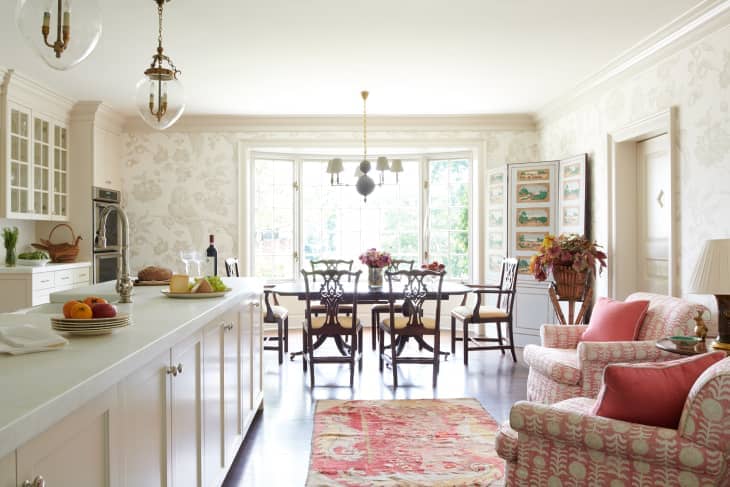
Take a quick peek through social media, and you’ll see that minimalist and mid-century modern styles dominate the draftsman world.
Everywhere you look, people swoon over bare walls, neutral colour palettes, and clean lines. Still, a new wave of designers and influencers have been rebelling against the plain, impersonal, and somewhat generic aesthetic.
That’s where grandmillennial home design comes in: a style that incorporates bold patterns, printed embellishments, and heirloom furniture.
In this blog, we’ll share some of the key elements of grandmillennial style. We’ll also share a few tips on how you can achieve the same look for your dream space.
Let’s begin!
What is grandmillennial home design?
Grandmillennial style is the name that’s appropriately given to the granny chic trend. The term first appeared in a 2019 House Beautiful article, which described the style as a mix of old and new.
The aesthetic is popular amongst 20- and 30-somethings who have grown tired of the simpler styles of the past decade.
It’s a neo-traditionalist movement for people who have a deep appreciation for older designs.
Key features of grandmillennial home design
1. Halfway between minimalism and maximalism
Grandmillennial design falls halfway between minimalism and maximalism. That sets it apart from Victorian or Baroque interior designs, which tend to layer one pattern after another.
To achieve this minimalist-maximalist combo, try combining ornate tufted furniture and grand chandeliers with simpler wall decor and window treatments.
Another way is to mix dark wood furniture pieces with contemporary art and metallic details. You can also try laying paisley print rugs underneath plain, solid-coloured furniture pieces.
2. Heirloom furniture and decor
A likely reason for the old-school resurgence is that many millennials have started inheriting furniture and decor pieces from their grandparents.
So, instead of discarding the items, they decorate their spaces with their grandparents’ vintage brass, slipcovers, fine china, ceramics, and vases.
3. Chintz everywhere
Indian chintz fabrics first became popular in Europe during the 17th century. They were adored by the English and the French for their gorgeous floral patterns and stunningly brilliant colours.
The textiles also have a practical use: due to their glazed nature, they can be easily wiped down and dusted.
Chintz fabrics saw a resurgence in the 1980s, where they served to soften sitting rooms with their distinctly feminine and floral appearance.
But perhaps due to overexposure, they fell out of fashion again years in favour of solid colours and minimalist designs.
Now that the grandmillennial trend is gaining momentum, it’s no surprise that chintz fabrics are also seeing a resurgence. Aside from upholstery, chintz patterns adorn windows and wall coverings.
4. Undeniably bright
One key element of grandmillennial homes is the abundance of light. While traditional Victorian or Edwardian-era interiors favoured dark woods and dim lighting, grandmillennial homes are always bright and refreshing.
After all, you can’t feature your home on YouTube or Instagram if it’s not bathed in light, right?
Grandmillennial homes typically feature large, floor-to-ceiling windows to let in natural light. These windows are then dressed with boldly patterned curtains to maintain the minimalist-maximalist theme.
In case you need help maximising natural light in your home, consult a building designer. They can help you find ways to brighten up your property, such as adding windows, knocking down non-load-bearing walls, or changing your home’s layout.
5. Boldly patterned decor
One reason that millennials are decorating their homes with boldly patterned furniture is that they grew up in the mass market furniture explosion. These pieces are typically plain, laidback, and remind them too much of their parents’ houses.
So, now that 20- and 30-somethings have their own homes, they want something different. They pick furniture, cushions, and curtains with refreshing botanical prints and embroidered patterns.
They choose pleated lampshades and blue-and-white Ming vases. There’s even room for monograms and fringe (trim).
6. Crafted decor
During the COVID-19 pandemic, many 20- and 30-somethings picked up new indoor hobbies like pottery, cross-stitching, and knitting.
These therapeutic hobbies gave people an opportunity to create one-of-a-kind and beautiful pieces while escaping their hectic lives.
It’s unsurprising, then, that decorating with handcrafted items also became a trend. In a grandmillennial home, it’s not uncommon to see cross-stitched pieces and hand-knitted rugs on display.
Give grandmillennial home design a try
Grandmillennial design is a fresh twist on the traditional. It seeks to rebel against the mid-century and minimalist styles that have dominated social media feeds for the past several years.
It’s for a generation that’s tired of plain, cookie-cutter interiors and is seeking to create something new yet nostalgic.
